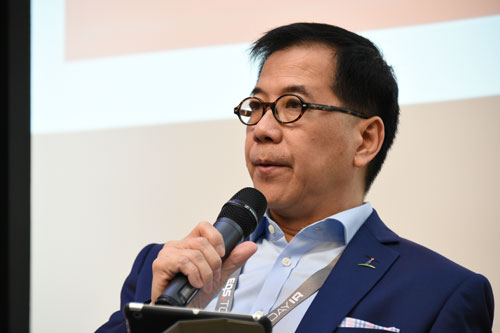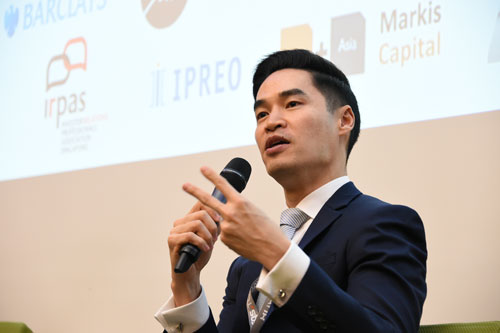An afternoon at Singapore Exchange
A sparkling venue and a new format were offered this year to the attendees of our annual South East Asia gathering, held on December 9 at Singapore Exchange (SGX). Coming for an afternoon of conference sessions and awards presentation, the local IR community as well as delegates from Indonesia, Malaysia, Thailand and the Philippines all appeared delighted to network and mingle with their peers at SGX’s stylishly renovated venue hall and auditorium.
After a welcome greeting from SGX’s CFO Chng Lay Chew, the event kicked off with a catch-up Q&A with Harold Woo, head of IR at CapitaLand and president of IRPAS, the Singaporean IR association. In addition to its regular corporate membership, the association now offers a new group scheme that includes three nominee spots and aims at increasing its 200-strong list of adherents.
Harold Woo, CapitaLand's head of IR and IRPAS president / Click here for the full photo gallery
IRPAS has been very active this past year, with eight networking events including a workshop on using LinkedIn to communicate the corporate story and a new International Certificate in Investor Relations based on the UK’s IR Society exam, for which ‘we’ve had a 96 percent passing rate,’ Woo enthused.
Communication trends
The first session was a panel discussion with buy-side and sell-side representatives discussing the most effective ways to communicate with investors and analysts. The mainstreaming of socially responsible investing was introduced by moderator Neil Stewart, editorial director of IR Magazine, who prompted the audience to vote with their smartphone: results revealed that nearly 40 percent had been asked a non-financial, ESG-related question this past year.
‘ESG criteria are a strategic comparative for investors with a longer time horizon,’ said Rebecca Lewis from Arisaig Partners, a Singapore-based asset manager investing with a 20-year view in listed consumer goods businesses in emerging markets. ‘A company is a going concern.’
Stewart explained that more and more sell-side firms in China are finding ways to work around firewalls so their researchers can access social media channels. ‘A lot of IROs use WeChat [a mobile text and voice messaging service developed by Chinese firm Tencent Holdings],’ added Queenie Chan, head of institutional corporate marketing for Asia ex-Japan at Barclays Capital. She advised the audience to ‘take control of news channels by being your own news center.’
Delegates at the IR Magazine Awards & Conference – South East Asia 2014
Polled on which region is most important to their IR strategy, 65 percent said Asia and 33 percent the US, with Europe garnering somewhat feeble interest. The result surprised Chan, who reportedly took more companies to Europe than to the US last year. ‘In general, I find Europe-based funds have a three-to-five year horizon,’ she said.
‘There are more questions about fundamentals, strategy and the big picture in those meetings, so it’s better to bring along either the CEO or the CFO. ‘In the US, you’ll find funds that are more sector-focused, with analysts who are ‘big’ on a certain sector,’ added Alex Lupis, head of corporate access and client management for Asia-Pacific equities at HSBC.
While investor conferences are still the most efficient way to meet a sizeable number of investors in one place, IROs from the audience noted that non-deal roadshows were the best use of their time and senior management’s. Chan also found conferences have started ‘to become commoditized. As a result, we’re now trying to develop smaller, in-depth meetings for our clients,’ she explained.
Asked about the impact of changes in UK regulation on corporate access, Lupis said brokers should take advantage of the UK’s Financial Conduct Authority’s concession, ‘which allows sell-side involvement in corporate access if there is value-added on the interaction. The sell side is not moving away from non-deal roadshows, but will rather get more engaged in meetings.’
IR case studies
After a short break, delegates retook their seats for the IR best practice case studies. Chaiyapat Paitoon, vice president of strategic planning at Thai firm Minor International, gave a highly instructive presentation on how his company, which owns 40 brands in the hospitality and fashion retailing businesses in 33 countries, has managed to simplify the IR message conveyed to investors and analysts.
His tips were to create an annual theme, sticking to ‘goals at high level’ for each business and to keep the firm’s story-telling consistent by using the same sequence and structure in their presentations. ‘We’ve color-coded our different businesses and applied the concept throughout all IR material,’ he explained.
Chaiyapat Paitoon, vice president of strategic planning at Minor International
In his presentation on ‘Understanding your shareholder base’, Ipreo’s managing director Justin Reynolds reminded the audience that shareholders will turn to third parties ‘if you don’t engage with them directly: proxy advisers such as ISS are only as powerful as you let them be.’
He also warned that US-type activism would, in time, be heading for Asia: ‘Some hedge funds are adopting longer-term strategies in order to allow sovereign wealth funds, which have been turning to alternative investments in search of higher returns, to enter their capital.’ Unfortunately, a typhoon over the Philippines prevented the attendance of Metro Pacific Investments’ Albert Pulido, who was due to discuss how his company disclosed management’s internal value for the business.
Media relations
‘Taming the media beast’ was the theme of the final session, which saw Bloomberg News’ managing editor for Asia Lars Klemming, Tulchan Communications’ senior partner Angela Campbell-Noe and StarHub’s chief marketing officer Jeannie Ong give tips on dealing with the financial media.
‘Taming the media beast’ panel
‘Global news groups such as the Financial Times or Wall Street Journal will rarely cover Asian companies’ results or transaction announcements in stand-alone articles, but rather as part of a sector or regional piece,’ explained Campbell-Noe, adding that these journalists will never provide questions in advance. ‘It isn’t Bloomberg’s policy, either,’ added Klemming. ‘We’d rather get a viewpoint that’s different from the official corporate message. Think about having something new to say if you don’t want your article to eventually be spiked.’
Ong insists every investor-facing executive at her firm undergoes media training. ‘You shouldn’t be a CFO at a listed company if you’re low profile,’ she warned. In addition to top management, all divisional heads go through training as well. ‘I’d rather speak to someone who’s been media trained,’ agrees Klemming. ‘So it’s clear for him or her just what he or she can disclose.’
‘Indeed, journalists’ bonuses depend on the number of file corrections that are required,’ Ong joked. But while a poll of the audience revealed that only 40 percent had actually received such preparation sessions, Ong emphasized that building good relationships with the media is paramount, since ‘it will help minimize potential misunderstandings.’
South East Asia awards
The conference was followed by drinks and the awards presentation, a moment of victory for DBS, which heads the South East Asia Top 25 rankings this year. The Singaporean bank took home six awards including the grand prix for best overall IR in the large-cap category, also scoring a third place in the Asia Top 50.
Adaro Energy’s senior IR manager, Andrew Kandolha, accepts the award for best IR by an Indonesian company
This year’s winners included Adaro Energy, Public Bank, CapitaLand, StarHub, Kasikornbank, Minor International, Metro Pacific Investments, PTT Exploration and Production, Singapore Technologies Engineering, Olam International and SingTel, while the accolade for best IR for an IPO was claimed by Pacific Radiance.










